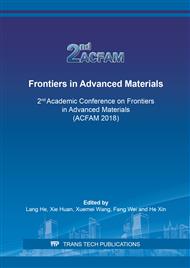p.273
p.282
p.294
p.305
p.317
p.324
p.332
p.342
p.352
Dispersion Properties of Nano-SiO2 under Single and Combined Actions of Sodium Hex Metaphosphate and Polycarboxylate Superplasticizer
Abstract:
Separate and combined effects of sodium hex metaphosphate (SHMP) and polycarboxylate superplasticizer (PCS) of different dosages (0.5%, 1%, 1.5%, and 2%) on the dispersion stability of nanoSiO2 (NS) were studied. The effect of the dispersant was characterized by the change of absorbance. When SHMP and PCS were used separately and in combination, the stability of nanoSiO2 dispersions was compared and the optimal amount of dispersant for different dosage of nanoSiO2 dispersions were summarized. Finally, the mechanism of dispersant compounding was discussed. The results show that with the increase of the concentration, the optimal amount of SHMP increases significantly while the optimal amount of PCS dispersant is lower and better than SHMP. A clear linear relationship between the optimal dosage of SHMP and the concentration of NS could be found. If SHMP is used combined with PCS, the stability of the dispersed NS will increase and the dosages of both dispersants will be reduced.
Info:
Periodical:
Pages:
352-360
Citation:
Online since:
June 2019
Authors:
Price:
Сopyright:
© 2019 Trans Tech Publications Ltd. All Rights Reserved
Share:
Citation:


